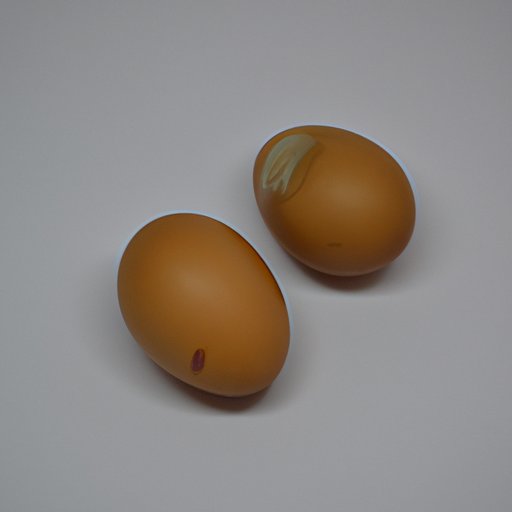
I. Introduction
Eggs are a staple ingredient in many dishes, from breakfast omelets to dinner entrees. But how can you tell if an egg has gone bad? Eating a bad egg can not only ruin the taste of a dish, but it can also lead to food poisoning. This article addresses this problem by providing step-by-step instructions on how to tell if an egg is bad using easy tests.
II. Conducting the Water Test
One of the easiest ways to test if an egg is bad is to conduct a water test. This simple test involves placing the egg in water to see if it sinks or floats. A fresh egg will sink to the bottom and lay flat on its side, while a bad egg will float.
To conduct the water test, follow these simple steps:
- Fill a bowl with cold water.
- Gently place the egg in the water.
- Observe the egg’s location in the water.
If the egg sinks to the bottom and lies flat, it is fresh. If it stands upright on the bottom, it is still edible but not as fresh. If the egg floats, it is bad and should be discarded immediately.
III. The Sniff Test
Another way to tell if an egg is bad is to conduct a sniff test. A bad egg will give off a foul odor, while a fresh egg will smell neutral. The sniff test can be conducted before cracking the egg to prevent any risk of contamination.
To conduct the sniff test, follow these simple steps:
- Bring the egg close to your nose.
- Smell the egg.
If the egg smells bad or rotten, it is no longer edible and should be discarded immediately.
IV. Visual Check
A visual check can also help determine if an egg is bad. This involves examining the egg for any cracks, molds, or discoloration.
To conduct a visual check, follow these simple steps:
- Inspect the egg for any cracks or chips in the shell.
- Check for any mold or discoloration on the shell.
- Observe the yolk and egg white for any abnormalities or unusual colors.
If the shell is cracked or the egg shows signs of mold or discoloration, it is bad and should be discarded immediately. If there are no visible signs of damage, further testing can be conducted to determine if the egg is good or bad.
V. The Shake Test
The shake test is another easy way to tell if an egg is bad. A bad egg will have a loose yolk and fluid-like egg white that can be heard sloshing around inside the shell. A fresh egg will have a firm yolk and thicker egg white that will stay in place when shaken.
To conduct the shake test, follow these simple steps:
- Hold the egg up to your ear.
- Shake the egg gently from side to side.
If you hear the sound of liquid sloshing around inside the shell, the egg is bad and should be discarded. If the egg is silent or only has a small amount of liquid movement, the egg is still fresh and can be used.
VI. The Float Test
The float test is similar to the water test, but it involves placing the egg in a glass of water instead of a bowl. This test can be more accurate than the water test for determining whether an egg is bad.
To conduct the float test, follow these simple steps:
- Fill a glass with cold water.
- Gently place the egg in the water.
- Observe the egg’s location in the water.
If the egg sinks to the bottom and lies flat, it is fresh. If it stands up on its pointed end, it is still edible but not as fresh. If the egg floats to the top, it is bad and should be discarded immediately.
VII. The Candle Test
The candle test involves shining a light through the egg to check for any abnormalities. This test can help detect any signs of blood or dark spots inside the egg.
To conduct the candle test, follow these simple steps:
- Hold the egg up to a bright light source.
- Look for any signs of blood, dark spots, or cloudiness inside the egg.
If the egg has any of these abnormalities, it is bad and should be discarded immediately. If the egg looks normal, it can be further tested using one of the other tests described above.
VIII. Best Practices for Storage
To keep eggs fresh and prevent them from going bad, it is important to follow proper storage practices.
The best practices for storing eggs include:
- Store eggs in their original carton in the refrigerator, not in the door.
- Keep eggs away from strong-smelling foods, such as onions or garlic, as they can absorb odors.
- Keep eggs at a constant temperature of 40°F or below.
- Do not wash eggs before storing, as this can remove the protective coating and increase the risk of bacteria entering the egg.
By following these storage practices, eggs can stay fresh for up to five weeks.
IX. Conclusion
Knowing how to tell if an egg is bad is an essential skill for any cook. By using the water test, sniff test, visual check, shake test, float test, and candle test, you can determine whether an egg is good or bad with confidence. By also following best practices for storage, you can help ensure your eggs stay fresh for longer. So next time you need to use eggs in a recipe, make sure to test them out and enjoy your delicious creation.
Remember, if in doubt, always err on the side of caution and discard any eggs that you suspect may be bad.




